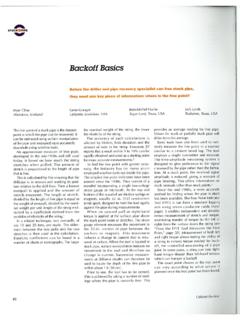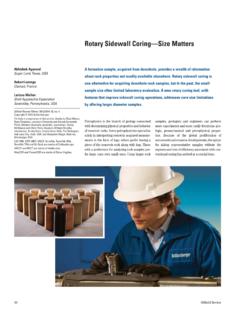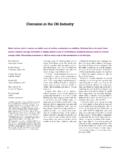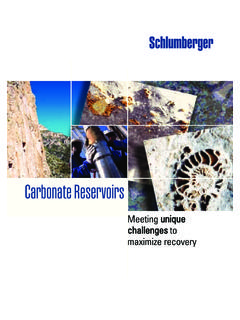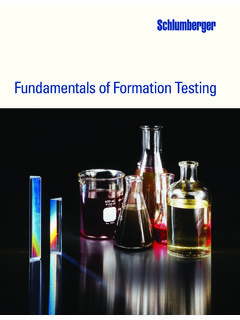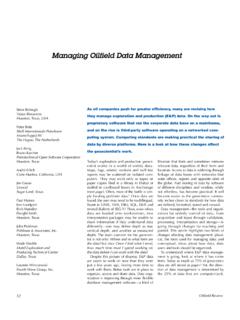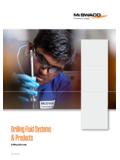Transcription of Casing Corrosion Measurement to Extend Asset Life
1 18 Oilfield ReviewCasing Corrosion Measurementto Extend Asset LifeCorrosion challenges are not new to the oil and gas industry, and producers arecontinually seeking new ways to keep Corrosion at bay. Experts have made advancesin Corrosion monitoring along several fronts. The implementation of these technolo-gies may help operators optimize infrastructure utilization, maximize production andminimize negative impact on the AbdallahMohamed FahimAbu Dhabi Company for Onshore OilOperationsAbu Dhabi, UAEK haled Al-HendiMohannad Al-MuhailanRam JawaleKuwait Oil CompanyAhmadi, KuwaitAdel Abdulla Al-KhalafQatar PetroleumDoha, QatarZaid Al-KindiAbu Dhabi, UAEA bdulmohsen S. Al-KuaitHassan B. Al-QahtaniKaram S. Al-YateemSaudi AramcoDhahran, Saudi ArabiaNausha AsrarSugar Land, Texas, USASyed Aamir KohringDhahran, Saudi ArabiaAbderrahmane BenslimaniAhmadi, KuwaitM. Aiman FituriDoha, QatarMahmut SengulHouston, TexasOilfield Review Autumn 2013: 25, no.
2 2013 help in preparation of this article, thanks to Ram SunderKalyanaraman, Clamart, , EM Pipe Scanner, FloView, Petrel, PipeView,PS Platform, Techlog, UCI and USI are marks and gas companies typically serve two mas-ters. On the one hand, profitability dictates thatproducers maximize long-term production whileminimizing operating expenditures. On the otherhand, environmental compliance requires thatcompanies conduct exploration and productionoperations safely and in an environmentallyresponsible manner.>Typical refining- Corrosion life cycle for metals. Energy is stored in a metal as it is refined from itsnaturally occurring state (such as iron ore) to an alloy. Corrosion takes place spontaneously andreleases the stored energy, which returns the metal back to a lower energy state. That process can beslowed by the application of one or more field-based mitigation Added During RefiningRefined Metal or AlloyIron Ore (Oxides) and Corrosion ProductsEnergy Released by CorrosionAutumn 20131919 The two mandates share a common enemy.
3 Corrosion , which is the natural tendency for materials to return to their most thermodynami-cally stable state by reacting with agents in the surrounding environment, attacks almost every component of a well. Wells are constructed pri-marily of steel, which is refined from naturally occurring iron ore. The process of refining ore into a steel alloy suitable for oil and gas drilling and production takes the ore to a higher energy state. Corrosion reverses this process and brings metal back toward its original, lower energy state (previous page).1 The process of Corrosion , which begins the moment steel is cast, is accelerated in the oil field by the presence of acidic species such as hydrogen sulfide [H2S] or carbon dioxide [CO2] in many formation fluids and by the elevated temperatures and pressures in producing forma-tions. The consequences of Corrosion include a reduction in wall thickness and loss of strength, ductility and impact strength in the steel that makes up the downhole tubulars, wellheads and surface piping and downstream processing equip-ment(right).
4 Failure to address corrosive attacks early impacts well profitability because operators must then implement potentially expensive, and per-haps extensive, mitigation methods. Not only does mitigation increase operating expenses, it may force operators to shut a well in for some period of time. In the worst cases, unattended Corrosion can lead to a leak or rupture, which may threaten the safety of oilfield personnel, lead to production losses and introduce hydrocarbons and other reservoir fluids into the total annual cost of Corrosion in the US alone is estimated at approximately US$ bil-lion, of which US$ 589 million is surface pipeline and facility costs, US$ 463 million is downhole tubing expenses and US$ 320 million is capital These estimates do not factor in the fines that may be levied by government regu-latory agencies against operators that experience a Corrosion -related discharge of production fluids into the environment.
5 The costs and risks may also increase as hydrocarbon sources are discovered in more-challenging environments deeper reservoirs with higher temperatures and pressures that contain higher concentrations of 1. For more on the Corrosion process: Brondel D, Edwards R, Hayman A, Hill D, Mehta S and Semerad T: Corrosion in the Oil Industry, Oilfield Review 6, no. 2 (April 1994): 4 Koch GH, Brongers MPH, Thompson NG, Virmani YP and Payer JH: Corrosion Costs and Preventive Strategies in the United States, Washington, DC: US Department of Transportation Federal Highway Administration, Office of Infrastructure Research and Development, Publication no. FHWA-RD-01-156, September 2001. >Summary of Corrosion problems and solutions. In the oil field, Corrosion is pervasive and takes many forms. By properly identifying the source of corrosive attack, an operator can implement a suitable Corrosion monitoring and control MethodsCause of CorrosionMonitoringOxygen corrosionSulfate-reducingbacteria (SRB)Hydrogen sulfide stress Corrosion crackingHydrogen-inducedcrackingAcid corrosionGalvanic (bimetallic) corrosionPitting Corrosion (rapidcorrosion at defectsin inert surface film)SubdepositcorrosionChloride Corrosion (rapid cracking onexposure to hotchloride media)
6 FatigueCrevice corrosionHydrogen sulfide Corrosion pittingCarbon dioxidecorrosion Water and oxygen sampling Iron counts Corrosion probes Oxygen sensors Coupon surveys Wall thickness surveys Visual internal inspections Visual surveys Anaerobic bacteria counts Chlorine residuals measurements Materials quality control Acid inhibitor checks Design reviews Equipment inspections Equipment inspections Bacteria counts Equipment inspections Oxygen analyses Equipment inspections Equipment disassembly and inspections Leak detections Probes Iron counts Wall thickness surveys Probes Iron counts Wall thickness surveys Resistant materials Oxygen scavengers Oxygen stripping Improved seal design Coatings Cathodic protection Biocides Chlorination Suitable materials Acid inhibitors Improved design Electrical isolation of metals (cathodic coating) Materials selection Pigging Biocides Improved sealing and design Minimum velocity design Materials selection Vibration design Improved design Materials selection Control of contaminated gas Degassing at low pressures Use of resistant materials Degassing at low pressures Control of contaminated gas Use of resistant materials Oxygenated water Internal attack External attack Anaerobic fluids Stagnant fluids Conditions under scales or other deposits Produced fluids containing hydrogen sulfide Anaerobic systems contaminated with SRB Stimulation and cleaning acids Two metals with different ionic potentials in a corrosive medium Immersion Inert surface films Wet solids deposits Biofilms Porous gaskets Salt solution Oxygen and heat Rotating equipment Wave.
7 Wind- or current-induced loading Poor design Imperfections in metal Water from production aquifer or other deep aquifer Water contaminated by stripping or lift gas Water from production aquifer or other deep aquifer Water contaminated by stripping or lift gas20 Oilfield Reviewacidic gases which may present more-aggres-sive Corrosion industry has advanced several methods tocombat Corrosion and Extend the operating life ofa well. These may be broadly classified into fourmain categories: metallurgy substituting traditional wellboretubulars with those manufactured with a corro-sion-resistant alloy (CRA) chemical modifying production fluids toreduce the intensity of corrosive attacks or cre-ating barriers that isolate the metal from pro-duced fluids through the application of aprotective coating injection pumping surfactant-base fluids thataggregate at the metal surface and block metal-water contact, thus inhibiting Corrosion cathodic protection using DC current to cre-ate impressed cathodic first option upgrading tubulars to thosecomposed of CRA may be cost prohibitive on alarge scale.
8 In the US alone, there are more than100,000 producing oil and gas wells with Casing ,tubing, wellheads, processing equipment andgathering may employ another mitiga-tion option: applying permanent coatings, whichcombat Corrosion by forming a resistant barrierbetween the corrosive fluid media and the metalsurface. Many coating types exist and are gener-ally categorized as follows: metallic zinc, chromium and aluminum inorganic enamels, glasses, ceramics andglass-reinforced linings organic epoxies, acrylics and with CRAs, coatings may promise a longeroperating life with reduced maintenance, butthey come at a cost may use inhibition by chemicalmeans during the production stage of the well tomitigate Corrosion on the internal surface of pip-ing and equipment. Corrosion inhibitors are typi-cally surfactant-base chemical formulations thatare added to the production stream in concentra-tions ranging from tens to several hundred partsper million (ppm).
9 The inhibitor moleculesmigrate and collect at surfaces; in the case of awell s production infrastructure, the moleculescollect at the metal surface to form a barrierbetween it and the corrosive fluid phase. In thisway, they act in a manner similar to that of a coat-ing, but at a lower cost than that of a permanentcoating or a CRA. Unlike a coating, a corrosioninhibitor must be reapplied to replenish theinhibitor film that is degraded or washed away bythe flowing action of the production prevention through cathodic pro-tection works by forcing anodic areas of themetal those susceptible to corrosive attack to become cathodic or noncorrosive. To accom-plish this, operators apply a DC current throughthe metal to counteract the Corrosion current atechnique known as impressed cathodic protec-tion (ICP) or use sacrificial anodes, which arecomposed of metal that has a greater corrosiontendency than the metal to be article focuses on Corrosion monitoringand Measurement techniques for downhole infra-structure during production.
10 Case studies fromthe Middle East demonstrate how Corrosion mon-itoring tools and mitigation technologies havehelped operators identify the location and sever-ity of Corrosion in the subsurface infrastructure,which informed each company s choice of mitiga-tion and the Life CycleCorrosion is a major concern throughout the lifeof a well, and specific considerations and mitiga-tion strategies are required at each stage. Assetpersonnel usually begin making Corrosion miti-gation decisions for a well before the well design stage, the operator con-ducts comprehensive reservoir studies, whichinclude reservoir simulation modeling, corestudies and fluid analysis from offset well use the information obtained fromthese studies to develop risk assessments forcorrosion threats in subsequent stages of thewell. Engineers then develop and implementmitigation strategies that include appropriatematerials selection, optimal production rates,monitoring programs and Corrosion inhibitortreatments(above).
